|
Some image of
May 21st, 2011
SPECIAL PRIZE
EUROFLORA
Themes
Regulation

Versione italiana
|
Section A
Landscape design in transformation of the territory
Action for the environment restoration, renewal and recovery
-
FIRST PRIZE
- PROGETTO PAESAGGISTICO DEL PARCO CENTRALE DI NANHU
Tangshan City (Hebei) - CINA -
-
INTERESTING EXAMPLE OF TRANSFORMATION THROUGH A SUSTAINABLE RECLAMATION OF THE ENTIRE ENVIRONMENT.
 Arch. Jie Hu Arch. Jie Hu
Ing. Lushan Lu - Lei Zhang - Chunjiao Li
Beijing Tsinghua Urban Planning & Design Institute (THUPDI) Department of Landscape Architecture (THDLA) Founded in 1993, Beijing Tsinghua Urban Planning & Design Institute was established on the academic foundation of Tsinghua University, taking advantage of its available talent. The institute asserts that urban planning practice must be combined with research and education in order to achieve broad experience in planning practice, strong technical superiority and outstanding academic quality. The Department of Landscape Architecture (THDLA), founded in 2003, is headed by Professor Jie Hu, a registered Landscape Architect and member of ASLA (American Society of Landscape Architecture). With an open cooperative attitude, THDLA unites many disciplines, developing extensive academic exchanges and cooperation both in China and abroad. Combining advanced landscape architecture design experience and modern landscape design technologies, THDLA engages in an active process to meet various clients demands from conceptual design through, design development, the preparation of construction documents and project implementation. Through thorough analyses and evaluation, THDLA has developed skills to produce projects that are unique to their context and have won many international and national design awards.
-
Project Team Leader Jie Hu, Director and Chief Designer of THDLA, Associate Professor at the School of Architecture in Tsinghua University, Registered Landscape Architect, Member of the American Society of Landscape Architects (ASLA), and Director of the Chinese Society of Landscape Architecture. Jie graduated from Chongqing Institute of Architecture and Engineering with a Bachelor degree of Architecture, Beijing Forestry University with a Master degree in Landscape Architecture and the University of Illinois at Urbana-Champaign with a Master of Land Resource Planning degree. After working at Sasaki Associates Inc. in the United States for 8 years, he returned to China in 2003, teaching two subjects at Tsinghua University - Landscape Technology and Landscape Design Studio. He is also the director and chief designer of THDLA and has been responsible for many renowned projects including Beijing Olympic Forest Park, Tieling Fanhe New City landscape planning, and Tangshan Nanhu Eco-city Central Park, which won 2009 ASLA Awards, six IFLA-APR Awards from 2007 to 2010 and the 2007 Torsanlorenzo International Prize. Based on his professional contribution to the landscape architecture practice, he was awarded the Beijing 2007 Foreign experts "Great Wall Friendship Award". Other recognition includes selection as a Beijing 2008 Olympic Games Torchbearer, Beijing Olympic Planning Project Exploring & Design and Mapping Industry Advanced Individual, Hi-tech Olympics Sophisticated Individual, and Chinese Science (2008) Man of the year.
Relation:
-
 Design concept Design concept: Transformation from Brownfield to Green Park Tangshan Nanhu Central Park is an urban public space focused primarily on the ecological restoration of a subsidence area. The natural environment, historical culture and needs of modern civilization were considerations that were integrated into the landscape design, based on thorough research and comprehensive analysis of the site and its surroundings. Existing essential landscape elements including mountains, water and wetlands were preserved, restored and reconstructed to form a holistically spatial structure with artificial spaces, creating an ecological security structure organically composed of natural and artificial components.
-
PROJECT NARRATIVE: Context
 Tangshan is a heavy industry city and it is regarded as the cradle of Chinese modern industry. Coal mining is the citys leading industry. Today, Tangshan has become the largest production base for coking coal in China. However, while contributing to the prosperity of Tangshan, the coal mining industry also brought many problems for the city: a subsidence area in the urban central region has expanded to 17.34km², which is 17.86% of the land available for urban construction, and the area increases1.3 km² every year as the coal mining activity continues. It has created a variety of impacts on the urban ecological environment and peoples lives and has seriously restricted the utilization and expansion of urban space. Nanhu Central Park is located 1 km south of the city center of Tangshan, in a 6.3 km² designated area. An existing underground coal field below the park site formed a large area of mined out space after more than 130 years of mining activity. In 1976, Tangshan suffered a 7.8 magnitude earthquake, and the excavated area subsided seriously, causing severe surface disturbance.  Consequently, Nanhu became the area most influenced by the Tangshan coal mining subsidence. After the earthquake, Tangshan started post-disaster reconstruction, but coal mining continued, based on the principle of economic production first, quality of life later. Because of the large subsidence and resumed mining activity, Nanhu could only be used to dump urban waste. It became a ruined area and safety hazard. By 2006, the subsidence area caused by coal mining activities had grown to 28 km². 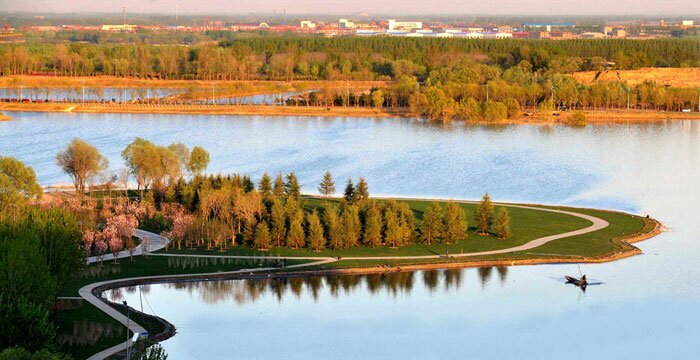 After 30 years of post-disaster reconstruction, Tangshan city had developed rapidly and finally had become the economic center of the Bohai region. However, Nanhu was still filled with urban, construction, and industrial waste, as well as domestic sewage. In the last 30 years, Collapse (caused by earthquake), subsidence (caused by coal mining), and the dumping of industrial waste and municipal refuse made the Nanhu area a typical urban brownfield. 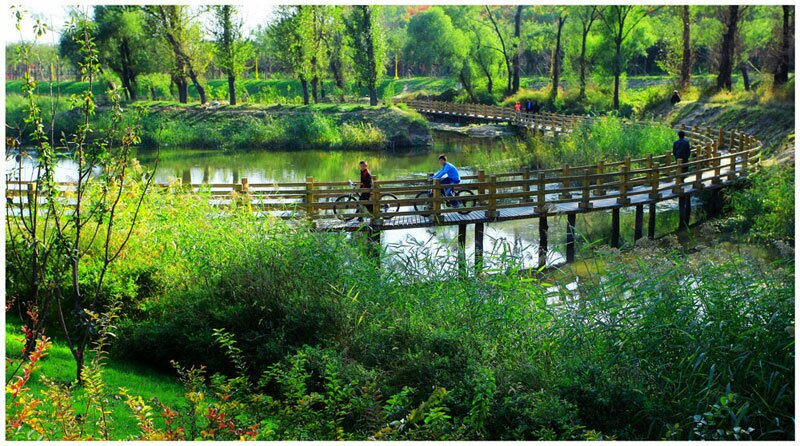 With Nanhu as a boundary, Tangshans southward expansion stopped abruptly. In 2008, China Seismological Bureau and Coal Science Research Institute did a comprehensive analysis and research regarding the geological structure and potential risk of continued coal mining subsidence in Nanhu, which announced: most of the Nanhu area is in a subsidence stability period, and has already met prerequisites for constructive development. Accordingly, the Tangshan government proposed a strategy of constructing Nanhu Eco-city, intended to transform what was previously an urban wasteland into a world class new eco-city.
-
SECOND PRIZE
- BATH AND COMMUNITY BUILDING CAMARADERIES
Seklerland -ROMANIA -
-
PROJECT INTERESTING FOR ITS PARTICIPATION OF THE LOCALVOLUNTEER WORK FROM HANDCRAFT SKILLS, MATERIALS, ACCOMMODATION OR FOOD AND PRAYER AND PERFORMED WITH RESPECT OF NATURE S FEATURES AND TREASURES.
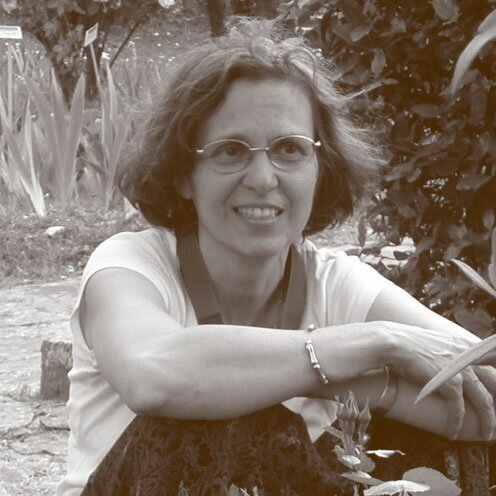 Arch. Ágnes Herczeg - Ars Topia Foundation Arch. Ágnes Herczeg - Ars Topia Foundation
Dr. Ágnes Herczeg MSc PhD
horticultural engineer and landscape architect, leading designer
Date of Birth: 30 November 1959, Budapest
Education
University
1979/84 Corvinus University of Budapest, Faculty of Landscape Architecture Msc 1984
Postgraduate studies
1994/97 Academic training at Hungarian Academy of Sciences Research at Corvinus University of Budapest, Faculty of Landscape Architecture, Landscape Protection and Regional Development PhD 2003
Scholarships
1995 Hungarian Academy of Sciences-Vienna, Collegium Hungaricum
1997 Hungarian Academy of Sciences-Lucca, Centro Studi Giardini Storici
Employment
1990- Pagony Landscape and Garden Architecture Ltd
l998-Transpagony Ltd, Romania
Professional activities
Active landscape and garden architectural planning-
Regional development projects, town planning
Public squares of settlements, parks
Historic gardens and environment
Research on the history of garden and landscape
Teaching experience
1998/2003 part-time teacher at Corvinus University of Budapest, Faculty of Landscape Architecture, Landscape
Protection and Regional Development, Department of Garden Art
2004-Sapientia Hungarian University of Transylvania, Faculty of Economic and Human Sciences, Miercurea-Ciuc
Public activities
Curator of Károly Kós Association - Curator of Imre Ormos Foundation - Curator of Ars Topia Foundation, Project
manager of traditional workcamps in Székely land
Awards
1994 Pro Natura Award (Ministry of Environment and Regional Development) /with the members of Pagony/
1998 Henry Ford Cultural Heritage Award / with the members of Pagony/
1998 Karoly Kos Award (Ministry of Agriculture and Rural Development) / with the members of Pagony/
-
Relation:
 Once upon a time far, far behind the woods and the river Maros, in the land of the fairies and giants next to the river Olt, on the foot of the mountains, before ten years there was an ambitious group of people, which started the reconstruction of the peoples baths during the community building camaraderie... If we stroll along the east side of the region, we find a lot of fountains and remains of traditional peoples baths. Once upon a time far, far behind the woods and the river Maros, in the land of the fairies and giants next to the river Olt, on the foot of the mountains, before ten years there was an ambitious group of people, which started the reconstruction of the peoples baths during the community building camaraderie... If we stroll along the east side of the region, we find a lot of fountains and remains of traditional peoples baths. 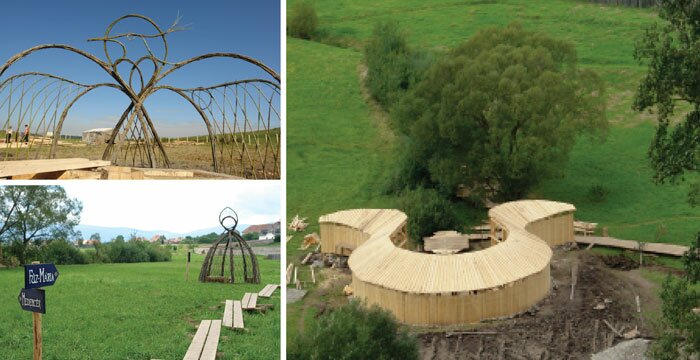 This landscape has a hidden but huge treasure, these mineral water springs, which the vernacular calls wine water springs. These springs are a result of the former volcanic activity in the regions terrain. The water of the fountains is very cold and has a significant curative power. That is why the people of this region always used the water of curative springs for their physical troubles. The curative springs are unobtrusively and simply matching the landscape, as the bathes, the inhabitants created around them are. During an official recreation program our office did a survey on the landscape features of the region, its curative springs and the baths in 2000. Through that in 2001 the first community building camaraderie of landscape architects, architects and the inhabitants of the village was possible. Also students of landscape architecture took part. All the attendants worked voluntarily. The first bath reconstruction took place on the edge of the village. Here we built the Birch Bath. The movement of the community building camaraderie still exists until today and grows every year. Until today 13 of the bath constructions could be implemented. The bath and community building camaraderie is a regional sort of work. It is volunteer work, which is based on love and during the work process every single attendant gives as much as he can to the joint work. They give their handicraft skills, materials, accommodation or food and prayer. The arriving volunteers and the inhabitants of the village do the reconstruction of the bath in collaboration. They build almost only with wood. The constructions are pools for the curative fountains or gazebos, pavilions, fountain houses, changing rooms, information systems and willow buildings. Every bath is a spiritual place, where next to the bodys cure also ones spirit can cure. That is why we deal very respectfully and conservatively with natures features and treasures. The community can bring the bath and community building camaraderie to life like it did in former times. We can experience the meaning of lovely work: the work, which is performed with and for each other, the power of communitys alliance, the joy of a joint creation, the richness of nature and the diversity of mineral water. This landscape has a hidden but huge treasure, these mineral water springs, which the vernacular calls wine water springs. These springs are a result of the former volcanic activity in the regions terrain. The water of the fountains is very cold and has a significant curative power. That is why the people of this region always used the water of curative springs for their physical troubles. The curative springs are unobtrusively and simply matching the landscape, as the bathes, the inhabitants created around them are. During an official recreation program our office did a survey on the landscape features of the region, its curative springs and the baths in 2000. Through that in 2001 the first community building camaraderie of landscape architects, architects and the inhabitants of the village was possible. Also students of landscape architecture took part. All the attendants worked voluntarily. The first bath reconstruction took place on the edge of the village. Here we built the Birch Bath. The movement of the community building camaraderie still exists until today and grows every year. Until today 13 of the bath constructions could be implemented. The bath and community building camaraderie is a regional sort of work. It is volunteer work, which is based on love and during the work process every single attendant gives as much as he can to the joint work. They give their handicraft skills, materials, accommodation or food and prayer. The arriving volunteers and the inhabitants of the village do the reconstruction of the bath in collaboration. They build almost only with wood. The constructions are pools for the curative fountains or gazebos, pavilions, fountain houses, changing rooms, information systems and willow buildings. Every bath is a spiritual place, where next to the bodys cure also ones spirit can cure. That is why we deal very respectfully and conservatively with natures features and treasures. The community can bring the bath and community building camaraderie to life like it did in former times. We can experience the meaning of lovely work: the work, which is performed with and for each other, the power of communitys alliance, the joy of a joint creation, the richness of nature and the diversity of mineral water.  The landscapes, which we admire for their diversity, their beauty and their nature, mean new adventures for most of us. Landscapes are a mirror of the people living inside of them, and those peoples connection to their landscape. This portrait of a landscape is constantly changing. We think it is important, to get to know the values of a landscape and the peoples liability. Based on these values we can evaluate our society or community. It depends on us, how they develop. The character, diversity, productivity and the possibility of the preservation of a landscape is in the hands of the community living inside of it. Lets live hand in hand with our landscapes! The landscapes, which we admire for their diversity, their beauty and their nature, mean new adventures for most of us. Landscapes are a mirror of the people living inside of them, and those peoples connection to their landscape. This portrait of a landscape is constantly changing. We think it is important, to get to know the values of a landscape and the peoples liability. Based on these values we can evaluate our society or community. It depends on us, how they develop. The character, diversity, productivity and the possibility of the preservation of a landscape is in the hands of the community living inside of it. Lets live hand in hand with our landscapes!
-
-
HONORARY MENTION
- IL RESTAURO DI UN BARCO SEICENTESCO E DEL SUO SINGOLARE GIARDINO
Ariccia (Roma) - ITALIA -
-
THE PROJECT COMBINES THE THEME OF THE ARCHITECTURAL RESTORATION WITH THAT OF ENVIRONMENTAL RECOVERY, WITHOUT ALTERING THE ESSENCE OF THE PLACE.
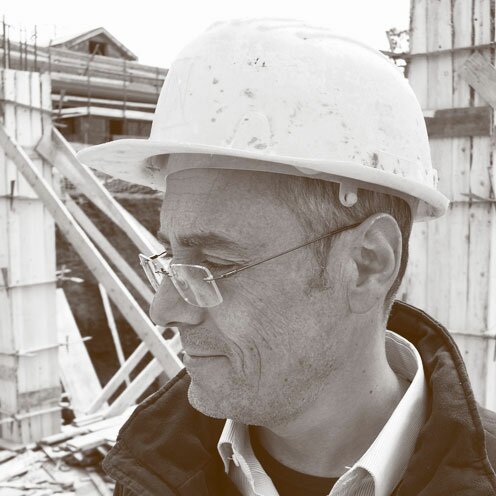 Arch. Virginio Melaranci - Arch. Cristina d'Angelo - Arch. Alessandro Amici Arch. Virginio Melaranci - Arch. Cristina d'Angelo - Arch. Alessandro Amici
Virginio Melaranci architect (1960).
Specializing in methods and instruments for urban planning. He works in the fields of architecture and urbanism, with particular attention given to experimentation of complex programmes and historical monuments restoration.
He founded with Paola DellAira, Gaetano Di Gesu, Paola Misino, Massimo Rosolini RDM-studio with which he has been received recognitions in national and international competitions, among which the I° prize at the Europan 3 competition.
Actually he is involved in Sforza Cesarinis Garden and Palace restoration at Genzano di Roma, in restoration of historical Garden of Chigis Palace at Ariccia, built by Bernini and Carlo Fontana, and in restructuring of sea-promenade in Santa Marinella near Rome.
-
Relation:
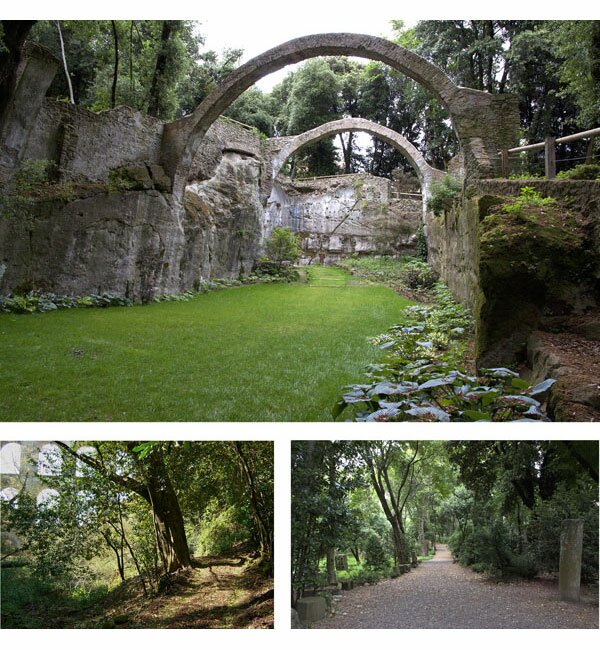 The configuration of this large park, in the surroundings of Rome, where Gian Lorenzo Bernini and his co-workers worked, is determined by an informal and organic spatial sensibility, which gradually led to the making of a large barco (a sort of a private hunting, typical of Italian Renaissance gardens), originally without a proper garden. The configuration of this large park, in the surroundings of Rome, where Gian Lorenzo Bernini and his co-workers worked, is determined by an informal and organic spatial sensibility, which gradually led to the making of a large barco (a sort of a private hunting, typical of Italian Renaissance gardens), originally without a proper garden.
The use of building "barchi", near the aristocratic palaces, especially since the mid-sixteenth century in Italy, is the expression of a tradition aiming to maintain a strict relationship with a nature viewed in its primitive and wild dimension. As we know, this approach is the antithesis of the formal garden tradition, much more practiced at that time, and characterized by a rationalization of the nature viewed as a space to be conquered, as one can see at its highest level in the spectacular near gardens of Tivoli, Bagnaia, Caprarola etc.
This characteristic of the park has been emerging during the centuries and today it appears as a confirmation of a specific "genius loci", derived from the ancient sacred forest dedicated to Diana (goddess of the forest), of which this park, originally, was a portion.
In this way a sort of reverential respect for the sacredness of the place prevailed throughout the centuries. This aspect clearly comes out if we consider the orography and trees density of the park, that are almost entirely those of the origin. In a few words a protection attitude for the vitality that this sacred forest evoked (and today still evokes) prevailed.
 An ancient owner, intellectual prince, at the end of 700, wished to preserve the wildness and the picturesque aspects of the park by excluding any silvicultural activitiy and even, avoiding to take away the woods of the fallen trees. An ancient owner, intellectual prince, at the end of 700, wished to preserve the wildness and the picturesque aspects of the park by excluding any silvicultural activitiy and even, avoiding to take away the woods of the fallen trees.
 The Grand Tour vogue brought many Italians and foreign visitors to know the Roman countryside, including this barco. Among these Turner, Fries, Corot, Frommel and many others, but also poets and writers such as Goethe, Stendhal, Seume, Sand, D'Annunzio. Goethe in 1787 writes: "...Ci siamo soffermati allingresso di un parco, tenuto (non dico mantenuto) dal suo proprietario,
, nel modo più strano: costui non vuol nemmeno che i passanti vi diano più che uno sguardo. Intanto vi si è formato un vero groviglio: alberi e cespugli, erbacce e tralci crescono come vogliono, si fan secchi, cadono, marciscono. E tutto va bene, e tutto anzi va per il meglio... Sarebbe un quadro del più grande effetto, se lo volesse fare un vero artista". The Grand Tour vogue brought many Italians and foreign visitors to know the Roman countryside, including this barco. Among these Turner, Fries, Corot, Frommel and many others, but also poets and writers such as Goethe, Stendhal, Seume, Sand, D'Annunzio. Goethe in 1787 writes: "...Ci siamo soffermati allingresso di un parco, tenuto (non dico mantenuto) dal suo proprietario,
, nel modo più strano: costui non vuol nemmeno che i passanti vi diano più che uno sguardo. Intanto vi si è formato un vero groviglio: alberi e cespugli, erbacce e tralci crescono come vogliono, si fan secchi, cadono, marciscono. E tutto va bene, e tutto anzi va per il meglio... Sarebbe un quadro del più grande effetto, se lo volesse fare un vero artista".
 Between the nineteenth and twentieth century the several interventions in the park, by the nobles owners, were not in opposition to these characteristics, as showed in some vintage pictures, where the park always appears to be kept in a free and informal aspect. Between the nineteenth and twentieth century the several interventions in the park, by the nobles owners, were not in opposition to these characteristics, as showed in some vintage pictures, where the park always appears to be kept in a free and informal aspect.
Perhaps this attitude was easier and more natural, in harmony with the soul of places, to indulge an aesthetic sensibility, by that time being dominant, that favoured informal spatial organizations of the gardens.
 It was through this way that, probably, were formed some faces of the barco, such as the piazzale dei mascheroni, the uccelliera (the aviary) and the giardino nuovo (new garden), which explicitly evoke romantic atmospheres of nineteenth century, with the presence of exotics trees trendy, as the Camellias, and the majestic Sequoias and Cryptomeria of piazzale dei mascheroni. It was through this way that, probably, were formed some faces of the barco, such as the piazzale dei mascheroni, the uccelliera (the aviary) and the giardino nuovo (new garden), which explicitly evoke romantic atmospheres of nineteenth century, with the presence of exotics trees trendy, as the Camellias, and the majestic Sequoias and Cryptomeria of piazzale dei mascheroni.
More recently, in the last decades, the park had increased its wild condition, until compromising the preservation of the same historical structures.
So, for example, happened within the uccelliera, with its suggestive ancient brick arcs, seriously damaged due to the invasion of looming oak trees.
An urgent restoration of the complex was really necessary. It lasted four years, from August 2006 to December 2010.
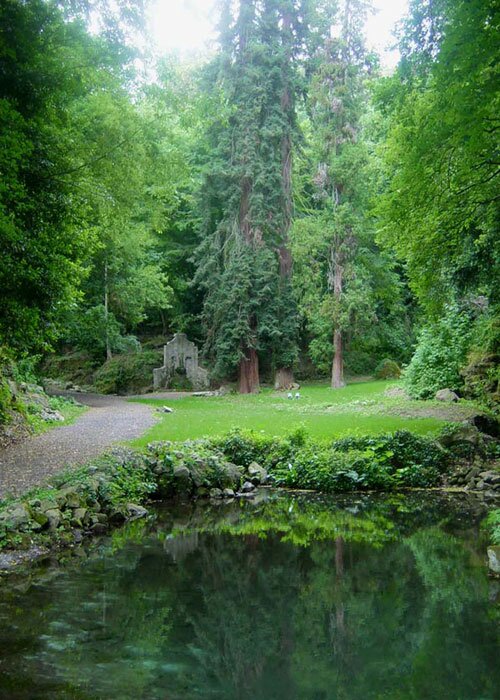 The restoration project The restoration project
To restore and make available an area with such a complexity, historical, botanical, cultural and silvicultural and so on, has meant, first of all, to determine which aspect of greenery should prevail.
A visit to this park is a really suggestive experience. It leaves us an impressive atmosphere of its overall complex but an unfocused image in order of its spatial organization. What remains in our mind is not the structure of space but a specific overall soul. The smell, the silence, the light and colours. From these considerations the restoration project moved.
Parco Chigis singularity is a very strong resistance of its landscape features, wild, virgin, never touched. It has been expanded to become a complex of 28 hectares, with several addictions, largely come intact up to us.
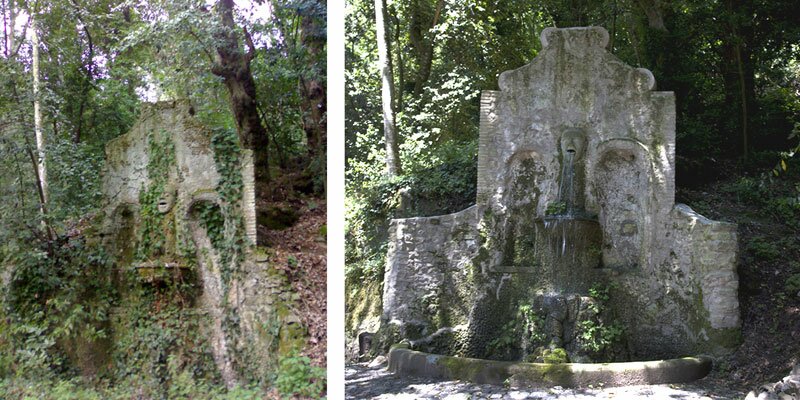 His distinctive features survived despite of the urban growth around, aggressive as everywhere into metropolitan area of Rome in the last decades of the last century. Today it's a fragment, or a relic, of the ancient forests that once cloaked these places. His distinctive features survived despite of the urban growth around, aggressive as everywhere into metropolitan area of Rome in the last decades of the last century. Today it's a fragment, or a relic, of the ancient forests that once cloaked these places.
The park, seen from the sky, looks like a green bubble, miraculously entrapped inside the surrounding city, or a fossil amber that, solidifying, has preserved the integrity and identity of what it contains.
-
|
SECTION A
SECTION B
SECTION C
PREVIOUS
EDITIONS
II edition - 2004
I edition - 2003
 Visita il Torsanlorenzo
Visita il Torsanlorenzo
Gruppo Florovivaistico
|




 Arch. Jie Hu
Arch. Jie Hu Design concept: Transformation from Brownfield to Green Park Tangshan Nanhu Central Park is an urban public space focused primarily on the ecological restoration of a subsidence area. The natural environment, historical culture and needs of modern civilization were considerations that were integrated into the landscape design, based on thorough research and comprehensive analysis of the site and its surroundings. Existing essential landscape elements including mountains, water and wetlands were preserved, restored and reconstructed to form a holistically spatial structure with artificial spaces, creating an ecological security structure organically composed of natural and artificial components.
Design concept: Transformation from Brownfield to Green Park Tangshan Nanhu Central Park is an urban public space focused primarily on the ecological restoration of a subsidence area. The natural environment, historical culture and needs of modern civilization were considerations that were integrated into the landscape design, based on thorough research and comprehensive analysis of the site and its surroundings. Existing essential landscape elements including mountains, water and wetlands were preserved, restored and reconstructed to form a holistically spatial structure with artificial spaces, creating an ecological security structure organically composed of natural and artificial components.
 Tangshan is a heavy industry city and it is regarded as the cradle of Chinese modern industry. Coal mining is the citys leading industry. Today, Tangshan has become the largest production base for coking coal in China. However, while contributing to the prosperity of Tangshan, the coal mining industry also brought many problems for the city: a subsidence area in the urban central region has expanded to 17.34km², which is 17.86% of the land available for urban construction, and the area increases1.3 km² every year as the coal mining activity continues. It has created a variety of impacts on the urban ecological environment and peoples lives and has seriously restricted the utilization and expansion of urban space. Nanhu Central Park is located 1 km south of the city center of Tangshan, in a 6.3 km² designated area. An existing underground coal field below the park site formed a large area of mined out space after more than 130 years of mining activity. In 1976, Tangshan suffered a 7.8 magnitude earthquake, and the excavated area subsided seriously, causing severe surface disturbance.
Tangshan is a heavy industry city and it is regarded as the cradle of Chinese modern industry. Coal mining is the citys leading industry. Today, Tangshan has become the largest production base for coking coal in China. However, while contributing to the prosperity of Tangshan, the coal mining industry also brought many problems for the city: a subsidence area in the urban central region has expanded to 17.34km², which is 17.86% of the land available for urban construction, and the area increases1.3 km² every year as the coal mining activity continues. It has created a variety of impacts on the urban ecological environment and peoples lives and has seriously restricted the utilization and expansion of urban space. Nanhu Central Park is located 1 km south of the city center of Tangshan, in a 6.3 km² designated area. An existing underground coal field below the park site formed a large area of mined out space after more than 130 years of mining activity. In 1976, Tangshan suffered a 7.8 magnitude earthquake, and the excavated area subsided seriously, causing severe surface disturbance.  Consequently, Nanhu became the area most influenced by the Tangshan coal mining subsidence. After the earthquake, Tangshan started post-disaster reconstruction, but coal mining continued, based on the principle of economic production first, quality of life later. Because of the large subsidence and resumed mining activity, Nanhu could only be used to dump urban waste. It became a ruined area and safety hazard. By 2006, the subsidence area caused by coal mining activities had grown to 28 km².
Consequently, Nanhu became the area most influenced by the Tangshan coal mining subsidence. After the earthquake, Tangshan started post-disaster reconstruction, but coal mining continued, based on the principle of economic production first, quality of life later. Because of the large subsidence and resumed mining activity, Nanhu could only be used to dump urban waste. It became a ruined area and safety hazard. By 2006, the subsidence area caused by coal mining activities had grown to 28 km².  After 30 years of post-disaster reconstruction, Tangshan city had developed rapidly and finally had become the economic center of the Bohai region. However, Nanhu was still filled with urban, construction, and industrial waste, as well as domestic sewage. In the last 30 years, Collapse (caused by earthquake), subsidence (caused by coal mining), and the dumping of industrial waste and municipal refuse made the Nanhu area a typical urban brownfield.
After 30 years of post-disaster reconstruction, Tangshan city had developed rapidly and finally had become the economic center of the Bohai region. However, Nanhu was still filled with urban, construction, and industrial waste, as well as domestic sewage. In the last 30 years, Collapse (caused by earthquake), subsidence (caused by coal mining), and the dumping of industrial waste and municipal refuse made the Nanhu area a typical urban brownfield.  With Nanhu as a boundary, Tangshans southward expansion stopped abruptly. In 2008, China Seismological Bureau and Coal Science Research Institute did a comprehensive analysis and research regarding the geological structure and potential risk of continued coal mining subsidence in Nanhu, which announced: most of the Nanhu area is in a subsidence stability period, and has already met prerequisites for constructive development. Accordingly, the Tangshan government proposed a strategy of constructing Nanhu Eco-city, intended to transform what was previously an urban wasteland into a world class new eco-city.
With Nanhu as a boundary, Tangshans southward expansion stopped abruptly. In 2008, China Seismological Bureau and Coal Science Research Institute did a comprehensive analysis and research regarding the geological structure and potential risk of continued coal mining subsidence in Nanhu, which announced: most of the Nanhu area is in a subsidence stability period, and has already met prerequisites for constructive development. Accordingly, the Tangshan government proposed a strategy of constructing Nanhu Eco-city, intended to transform what was previously an urban wasteland into a world class new eco-city.
 Arch. Ágnes Herczeg - Ars Topia Foundation
Arch. Ágnes Herczeg - Ars Topia Foundation Once upon a time far, far behind the woods and the river Maros, in the land of the fairies and giants next to the river Olt, on the foot of the mountains, before ten years there was an ambitious group of people, which started the reconstruction of the peoples baths during the community building camaraderie... If we stroll along the east side of the region, we find a lot of fountains and remains of traditional peoples baths.
Once upon a time far, far behind the woods and the river Maros, in the land of the fairies and giants next to the river Olt, on the foot of the mountains, before ten years there was an ambitious group of people, which started the reconstruction of the peoples baths during the community building camaraderie... If we stroll along the east side of the region, we find a lot of fountains and remains of traditional peoples baths.  This landscape has a hidden but huge treasure, these mineral water springs, which the vernacular calls wine water springs. These springs are a result of the former volcanic activity in the regions terrain. The water of the fountains is very cold and has a significant curative power. That is why the people of this region always used the water of curative springs for their physical troubles. The curative springs are unobtrusively and simply matching the landscape, as the bathes, the inhabitants created around them are. During an official recreation program our office did a survey on the landscape features of the region, its curative springs and the baths in 2000. Through that in 2001 the first community building camaraderie of landscape architects, architects and the inhabitants of the village was possible. Also students of landscape architecture took part. All the attendants worked voluntarily. The first bath reconstruction took place on the edge of the village. Here we built the Birch Bath. The movement of the community building camaraderie still exists until today and grows every year. Until today 13 of the bath constructions could be implemented. The bath and community building camaraderie is a regional sort of work. It is volunteer work, which is based on love and during the work process every single attendant gives as much as he can to the joint work. They give their handicraft skills, materials, accommodation or food and prayer. The arriving volunteers and the inhabitants of the village do the reconstruction of the bath in collaboration. They build almost only with wood. The constructions are pools for the curative fountains or gazebos, pavilions, fountain houses, changing rooms, information systems and willow buildings. Every bath is a spiritual place, where next to the bodys cure also ones spirit can cure. That is why we deal very respectfully and conservatively with natures features and treasures. The community can bring the bath and community building camaraderie to life like it did in former times. We can experience the meaning of lovely work: the work, which is performed with and for each other, the power of communitys alliance, the joy of a joint creation, the richness of nature and the diversity of mineral water.
This landscape has a hidden but huge treasure, these mineral water springs, which the vernacular calls wine water springs. These springs are a result of the former volcanic activity in the regions terrain. The water of the fountains is very cold and has a significant curative power. That is why the people of this region always used the water of curative springs for their physical troubles. The curative springs are unobtrusively and simply matching the landscape, as the bathes, the inhabitants created around them are. During an official recreation program our office did a survey on the landscape features of the region, its curative springs and the baths in 2000. Through that in 2001 the first community building camaraderie of landscape architects, architects and the inhabitants of the village was possible. Also students of landscape architecture took part. All the attendants worked voluntarily. The first bath reconstruction took place on the edge of the village. Here we built the Birch Bath. The movement of the community building camaraderie still exists until today and grows every year. Until today 13 of the bath constructions could be implemented. The bath and community building camaraderie is a regional sort of work. It is volunteer work, which is based on love and during the work process every single attendant gives as much as he can to the joint work. They give their handicraft skills, materials, accommodation or food and prayer. The arriving volunteers and the inhabitants of the village do the reconstruction of the bath in collaboration. They build almost only with wood. The constructions are pools for the curative fountains or gazebos, pavilions, fountain houses, changing rooms, information systems and willow buildings. Every bath is a spiritual place, where next to the bodys cure also ones spirit can cure. That is why we deal very respectfully and conservatively with natures features and treasures. The community can bring the bath and community building camaraderie to life like it did in former times. We can experience the meaning of lovely work: the work, which is performed with and for each other, the power of communitys alliance, the joy of a joint creation, the richness of nature and the diversity of mineral water.  The landscapes, which we admire for their diversity, their beauty and their nature, mean new adventures for most of us. Landscapes are a mirror of the people living inside of them, and those peoples connection to their landscape. This portrait of a landscape is constantly changing. We think it is important, to get to know the values of a landscape and the peoples liability. Based on these values we can evaluate our society or community. It depends on us, how they develop. The character, diversity, productivity and the possibility of the preservation of a landscape is in the hands of the community living inside of it. Lets live hand in hand with our landscapes!
The landscapes, which we admire for their diversity, their beauty and their nature, mean new adventures for most of us. Landscapes are a mirror of the people living inside of them, and those peoples connection to their landscape. This portrait of a landscape is constantly changing. We think it is important, to get to know the values of a landscape and the peoples liability. Based on these values we can evaluate our society or community. It depends on us, how they develop. The character, diversity, productivity and the possibility of the preservation of a landscape is in the hands of the community living inside of it. Lets live hand in hand with our landscapes!
 Arch. Virginio Melaranci - Arch. Cristina d'Angelo - Arch. Alessandro Amici
Arch. Virginio Melaranci - Arch. Cristina d'Angelo - Arch. Alessandro Amici The configuration of this large park, in the surroundings of Rome, where Gian Lorenzo Bernini and his co-workers worked, is determined by an informal and organic spatial sensibility, which gradually led to the making of a large barco (a sort of a private hunting, typical of Italian Renaissance gardens), originally without a proper garden.
The configuration of this large park, in the surroundings of Rome, where Gian Lorenzo Bernini and his co-workers worked, is determined by an informal and organic spatial sensibility, which gradually led to the making of a large barco (a sort of a private hunting, typical of Italian Renaissance gardens), originally without a proper garden. An ancient owner, intellectual prince, at the end of 700, wished to preserve the wildness and the picturesque aspects of the park by excluding any silvicultural activitiy and even, avoiding to take away the woods of the fallen trees.
An ancient owner, intellectual prince, at the end of 700, wished to preserve the wildness and the picturesque aspects of the park by excluding any silvicultural activitiy and even, avoiding to take away the woods of the fallen trees. The Grand Tour vogue brought many Italians and foreign visitors to know the Roman countryside, including this barco. Among these Turner, Fries, Corot, Frommel and many others, but also poets and writers such as Goethe, Stendhal, Seume, Sand, D'Annunzio. Goethe in 1787 writes: "...Ci siamo soffermati allingresso di un parco, tenuto (non dico mantenuto) dal suo proprietario,
, nel modo più strano: costui non vuol nemmeno che i passanti vi diano più che uno sguardo. Intanto vi si è formato un vero groviglio: alberi e cespugli, erbacce e tralci crescono come vogliono, si fan secchi, cadono, marciscono. E tutto va bene, e tutto anzi va per il meglio... Sarebbe un quadro del più grande effetto, se lo volesse fare un vero artista".
The Grand Tour vogue brought many Italians and foreign visitors to know the Roman countryside, including this barco. Among these Turner, Fries, Corot, Frommel and many others, but also poets and writers such as Goethe, Stendhal, Seume, Sand, D'Annunzio. Goethe in 1787 writes: "...Ci siamo soffermati allingresso di un parco, tenuto (non dico mantenuto) dal suo proprietario,
, nel modo più strano: costui non vuol nemmeno che i passanti vi diano più che uno sguardo. Intanto vi si è formato un vero groviglio: alberi e cespugli, erbacce e tralci crescono come vogliono, si fan secchi, cadono, marciscono. E tutto va bene, e tutto anzi va per il meglio... Sarebbe un quadro del più grande effetto, se lo volesse fare un vero artista". Between the nineteenth and twentieth century the several interventions in the park, by the nobles owners, were not in opposition to these characteristics, as showed in some vintage pictures, where the park always appears to be kept in a free and informal aspect.
Between the nineteenth and twentieth century the several interventions in the park, by the nobles owners, were not in opposition to these characteristics, as showed in some vintage pictures, where the park always appears to be kept in a free and informal aspect. It was through this way that, probably, were formed some faces of the barco, such as the piazzale dei mascheroni, the uccelliera (the aviary) and the giardino nuovo (new garden), which explicitly evoke romantic atmospheres of nineteenth century, with the presence of exotics trees trendy, as the Camellias, and the majestic Sequoias and Cryptomeria of piazzale dei mascheroni.
It was through this way that, probably, were formed some faces of the barco, such as the piazzale dei mascheroni, the uccelliera (the aviary) and the giardino nuovo (new garden), which explicitly evoke romantic atmospheres of nineteenth century, with the presence of exotics trees trendy, as the Camellias, and the majestic Sequoias and Cryptomeria of piazzale dei mascheroni. The restoration project
The restoration project His distinctive features survived despite of the urban growth around, aggressive as everywhere into metropolitan area of Rome in the last decades of the last century. Today it's a fragment, or a relic, of the ancient forests that once cloaked these places.
His distinctive features survived despite of the urban growth around, aggressive as everywhere into metropolitan area of Rome in the last decades of the last century. Today it's a fragment, or a relic, of the ancient forests that once cloaked these places.